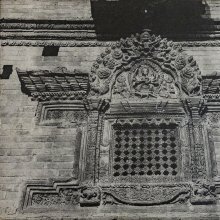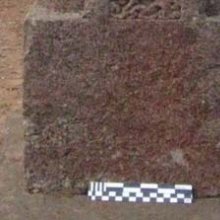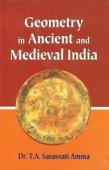Square: 2 definitions
Introduction:
Square means something in Hinduism, Sanskrit. If you want to know the exact meaning, history, etymology or English translation of this term then check out the descriptions on this page. Add your comment or reference to a book if you want to contribute to this summary article.
Images (photo gallery)
(+23 more images available)
In Hinduism
Vastushastra (architecture)
Source: Shodhganga: Elements of Art and Architecture in the Trtiyakhanda of the Visnudharmottarapurana (vastu)Square-shaped Temples (in ancient Indian architecture) are described in literature such as the Viṣṇudharmottarapurāṇa, an ancient Sanskrit text which (being encyclopedic in nature) deals with a variety of cultural topics such as arts, architecture, music, grammar and astronomy.—Temples like saumudga, nandī, vṛtta, vṛṣa etc. were constructed in circular or round shape. According to Viṣṇudharmottarapurāṇa, the kaṭi i.e., waist part and the mekhalā i.e., the slop of the digvandha type of temple should be made in circular shape. Ānanda type of temple should be constructed in square or circular shape.

Vastushastra (वास्तुशास्त्र, vāstuśāstra) refers to the ancient Indian science (shastra) of architecture (vastu), dealing with topics such architecture, sculpture, town-building, fort building and various other constructions. Vastu also deals with the philosophy of the architectural relation with the cosmic universe.
Yoga (school of philosophy)
Source: ORA: Amanaska (king of all yogas): A Critical Edition and Annotated Translation by Jason BirchThe Square shape is denoted in the Sanskrit language as Catuṣkoṇa, according to the twelfth-century Vivekamārtaṇḍa 158.—Accordingly, “Having become absorbed in the earth element, which is bright like orpiment and gold, yellow, endowed with the syllable la, presided over by Brahmā, square [in shape] [i.e., catuṣkoṇa] and located in the heart, [the Yogin] should hold his breath and mind in it for two hours. This dhāraṇā on the earth [element] makes [the Yogin] constantly steady and a master of the earth [element]”.

Yoga is originally considered a branch of Hindu philosophy (astika), but both ancient and modern Yoga combine the physical, mental and spiritual. Yoga teaches various physical techniques also known as āsanas (postures), used for various purposes (eg., meditation, contemplation, relaxation).
See also (Relevant definitions)
Starts with: Square-nut hickory, Square-stemmed monkey-flower.
Full-text (+1024): Caturashra, Vargamula, Varga, Catuhshala, Bhadraganita, Bhinnavarga, Parikarmashtaka, Vargaghana, Catushkona, Sarvatobhadra, Vargavarga, Vastumandala, Samacaturbhuja, Khanalem, Pophali, Bulabulacashmi, Ghanavarga, Kriti, Bhumiparimana, Vishamakarman.
Relevant text
Search found 197 books and stories containing Square; (plurals include: Squares). You can also click to the full overview containing English textual excerpts. Below are direct links for the most relevant articles:
The Agni Purana (by N. Gangadharan)
Chapter 40 - The mode of making the respectful offering to the god
Chapter 93 - Mode of worshipping the presiding deity of a ground (vāstupūjā)
The Shiva Purana (by J. L. Shastri)
Chapter 5 - The rules governing the mystic diagram of the ascetic < [Section 6 - Kailāsa-saṃhitā]
Chapter 42 - Description of the meeting of the lord and the mountain < [Section 2.3 - Rudra-saṃhitā (3): Pārvatī-khaṇḍa]
Chapter 8 - Śiva’s Mental worship < [Section 6 - Kailāsa-saṃhitā]
Kashyapa Shilpa-shastra (study) (by K. Vidyuta)
4.3. Vāstupada-vinyāsa (site-planning) < [Chapter 1 - Introduction]
4. Fourteen types of Samāśra (Square) Maṇḍapas < [Chapter 4 - Maṇḍapa Lakṣaṇa]
6. Description of Maṇḍapa Walls and Stairways < [Chapter 4 - Maṇḍapa Lakṣaṇa]
Vastu-shastra (1): Canons of Architecture (by D. N. Shukla)
(ii) The Site-planning (Vāstupada-vīnyāsa) < [Chapter 6 - Fundamental Canons of Hindu Architecture]
(v) Mānasāra (Summary) < [Chapter 5 - Study of Hindu Science of Architecture]
(iii) Proportionate measurements (Māna, Aṅgula, Hasta) < [Chapter 6 - Fundamental Canons of Hindu Architecture]
Brihat Samhita (by N. Chidambaram Iyer)
Chapter 53 - On House-building (vāstu-vidyā)
Chapter 71 - Omens from Slits of Garments (vastracheda-lakṣaṇa)
Gati in Theory and Practice (by Dr. Sujatha Mohan)
Gati in classical form of Kathakali < [Chapter 4 - Practice of Gati]
Gaits according to theatre < [Chapter 2 - Concept and technique of Gati]
Gati, as found in classical theatres of Kūḍiāṭṭam < [Chapter 4 - Practice of Gati]
Related products







